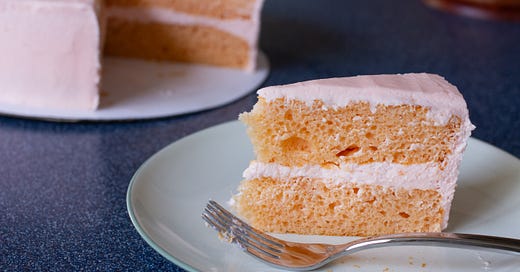Rosé Cake
The more I bake, the more I realize recipe developers actually know what they’re doing.
The recipe
Yield: one layer cake, about 16 servings
Time: 3 hours, plus cooling time
Ingredients
1 bottle (750 mL) rosé wine (one you’d enjoy drinking)
Cake:
1 box Duncan Hines Perfectly Moist Classic White Cake Mix
1 box vanilla instant pudding mix (3.4 oz/96 g)
4 eggs
½ c (80 g) vegetable oil
½ stick (4 tbsp or 57 g) salted butter
4–6 drops red food coloring (optional)
Frosting:
5 egg whites
1 and ½ c (345 g) sugar
4 sticks (1 lb or 900 g) salted butter, cubed, at room temperature
3 drops red food coloring (optional)
Instructions
1. Pour the entire bottle of rosé into a small saucepan and boil it on high heat until it is reduced down to 1 ¾ c (420 mL) of liquid, 10–20 mins. Divide it into three portions: 1 c, ½ c, and ¼ c.
2. While the rosé is reducing, preheat the oven to 350°F and line the bottoms of two 9-inch round baking pans with parchment paper. Grease the sides with butter and set aside.
3. Also while the rosé is boiling, assemble the cake batter. Place the cake mix, pudding mix, eggs, vegetable oil, melted butter, and food coloring in the bowl of a stand mixer fitted with the paddle attachment and mix on low speed until mostly combined. (The batter should still look a little streaky).
4. When the rosé is finished reducing, pour 1 c into the cake batter and mix on low speed for about 30 seconds.
5. Scrape down the sides and bottom of the bowl and increase the speed to medium. Beat for 2 minutes. The batter should look smooth and uniform when you’re done.
6. Pour the batter into the prepared pans and bake on the middle rack of the oven for 20–25 minutes, until a toothpick inserted in the middle comes out with a few cooked crumbs clinging to it.
7. Using the ¼ c of reserved rosé, brush some of it over the top of the cakes as soon as they come out of the oven.
8. Let the cakes cool in their pans for 10 minutes.
9. After 10 minutes, line two wire racks with parchment paper. Run a knife around the sides of the cakes and turn them out onto the cooling racks.
10. Remove the parchment from the bottom of the cakes and brush them with whatever rosé remains from your ¼ c. Allow them to cool fully.
Frosting:
1. While the cakes are cooling, bring a small pot of water on the stove to a simmer.
2. Place the egg whites and sugar in the bowl of a stand mixer, and place that bowl on top of the pot of simmering water. Make sure the water doesn’t touch the bottom of the bowl.
3. Whisk the egg whites and sugar constantly until the sugar dissolves, the mixture turns foamy and pale, and it reaches a temperature of 160°F.
4. Attach the bowl to a stand mixer fitted with the whisk attachment. Whip the meringue on medium-high speed until it cools to room temperature (the sides of the bowl no longer feel warm to the touch), about 20 minutes.
5. Reduce the mixer speed to medium and switch from the whisk to the paddle attachment.
6. Add the butter slowly, 1 tbsp at a time, making sure each addition is fully incorporated before adding the next. Your frosting will get a little soupy, but keep adding the butter and it will firm up again.
7. Add the remaining ½ c concentrated rosé, 1 tbsp at a time. Incorporate each addition thoroughly before adding the next. Add the food coloring and mix to combine.
8. When the cake layers are fully cool, place one layer on a cake plate. Spread 1 cup of frosting on it, then stack the second layer on top. Frost the sides and top of the cake. It will keep at room temperature for a few days if stored in an airtight container or on a cake stand with a lid.
Notes and tips
Buy a rosé wine you would happily drink on its own. Look for something with a decent amount of acidity and some floral or fruity flavors. (I liked Aquarelle, which was from Wegman’s, and J.L. Quinson Côtes de Provence from Trader Joe’s.)
To get my butter to room temperature, I take it out of the fridge before I start the recipe and cut it up into small pieces. I leave those out on a plate, and by the time the meringue is cool, the butter is warm.
Cubed butter doesn’t have to be actual cubes, just small pieces. I cut a stick into 16 slices and call it good.
The larger the diameter of your pot, the faster the rosé will reduce.
The cake will look a little lumpy right out of the oven, but it will even out as it cools.
If you want the meringue to cool faster, roll up some ice cubes in a towel and hold the towel to the outside of the mixing bowl.
For more tips on baking and assembling layer cakes, check out my Guide to Better Cakes.
You now have 5 egg yolks sitting in your fridge. That’s a problem. But it’s also the perfect number for my Elderflower and Lime Crème Brûlée recipe.
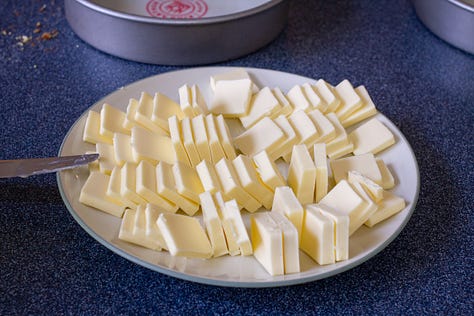
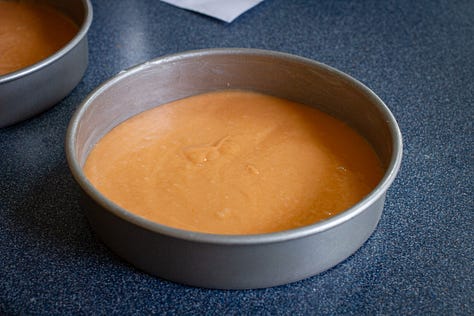
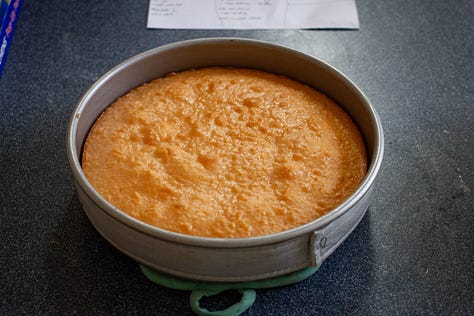


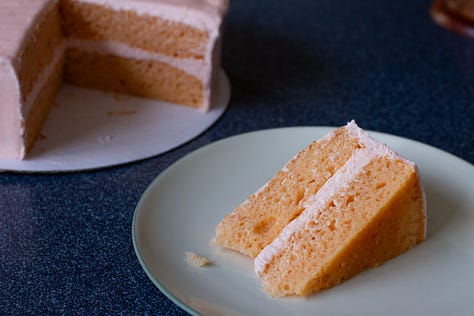
The story
I used to habitually disregard certain recipe instructions. Bringing my butter to room temperature before making cookies? I never did, then wondered why my cookies spread so much. Using regular instead of superfine sugar in a pavlova? Surely it couldn’t make that much of a difference. A weepy, sad meringue proved me wrong. Cooking with a wine I’d actually drink? I bought the “cooking wine” at the grocery store and never had a problem.
And then I made this cake. I bought the cheapest wine I could find (1.5 L for $15—what a steal!), poured myself a glass, didn’t love it, but didn’t think any more about it. Rosés are usually too acidic for me, anyway.
After a few rounds of testing, I hit a wall. I’d tried boiling down the wine to concentrate the flavor, I’d tried boiling it down even more, I’d tried soaking the cake after baking it, and some of my taste testers still couldn’t taste the rosé. I wasn’t sure what to do.
My friend Alex had suggested trying a wine that tasted like strawberries. Maybe a nicer bottle would make a difference? I know nothing about rosé, but BC appreciates it, so I poured him a glass of the one I’d been using. He took one sip, made a face, and poured the rest down the drain.
I researched the best rosés at Wegman’s, bought one, and sampled it before baking with it. To my surprise, I enjoyed it. It was certainly acidic and not at all sweet, but it had notes of apricot and smelled a little like honeysuckle.
This next cake was way better. It was more fragrant, had a stronger flavor, and there was a pleasant, subtle tanginess in both the cake and the frosting. Turns out all those recipes calling for a decent wine were right—spending $20 for a bottle was worth it.
P.S. If you go to Trader Joe’s, you can spend even less—I used one of their $10 rosés to make another excellent cake.
Spread the Snob
If you like this recipe, please recommend Confessions of a Cake Snob to someone you know! Follow me on Pinterest or Instagram for more ways to view and save the recipes. Please share this newsletter with a friend, comment on the website, or bake it and let me know how it went for you! Email me with comments, ideas, and suggestions at confessionsofacakesnob@substack.com.

